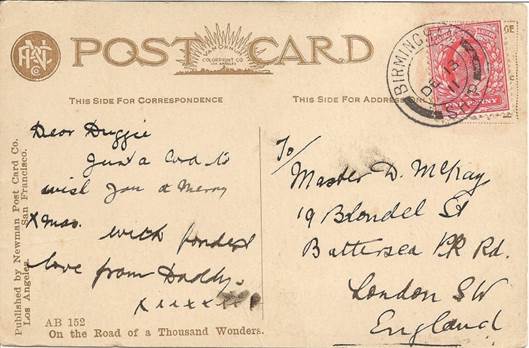Seapost -> Ship Letters -> Birmingham Ship Letter mark census
Birmingham Ship Letter mark census
By Ian Baker

ppc of “The Poinsettia”, California’s Christmas Flower, stamped with Edward VII 1d (SG219) and tied by double ring Birmingham ‘Ship’ dated DE 13/11.
Since 2011 the Society, through member Ian Baker, has been tracking down examples of the Birmingham Ship Letter and attempting to explain why a city at the geographic centre of England should have been issued with such a mark. The current census of known covers is listed in the downloadable file to be found at the bottom of this page. If you have a cover not in this list the Society would welcome a scan which may be emailed by means of the address on the contact page.
Possible scenarios:
Option 1: Items with foreign paquebot marks, were forwarded to UK ports as separate mail. They were not UK port paquebot items, nor were they ‘on board’ items arriving on British registered ships. All these items with no country of origin may have been sorted together at the Plymouth & Bristol TPO (Foreign Mail) ‘building’ and then sent, in sealed bags, to be sorted at and distributed from Birmingham, where they received the ‘Ship’ mark, issued to identify such incoming ship mail. All other mail, originating from overseas countries, was sorted and distributed by the quickest means. Posted ‘on board’ mail arriving on foreign registered ships received the local UK port paquebot mark.
Option 2: All mail from any ship was sorted by bag at Plymouth, mail for London being despatched immediately. If the amount of other destined mail was too great, the extra bags were sent by rail to Bristol, where if they could not cope, sent the remaining bags to Birmingham. The ‘on board’ mail arriving on ‘foreign’ registered ships was directed to Plymouth HO, where it was stamped with a paquebot mark. It is assumed the four southern England items in the census, were miss-sorted into the wrong ‘Road’ bags.
Option 3: Small bundles of ‘loose letters’ received a Plymouth paquebot handstamp; liners contracted to carry mail transferred all their mailbags to tender and then, depending on the destination label, to mail coaches bound for either London (possibly 75-80% of the mail) or Bristol, where some was sorted for Birmingham to be cancelled. Again it is assumed the four southern England items in the census, were miss-sorted into the wrong ‘Road’ bags.
Census of Birmingham Ship Letter marks recorded to date
The list is provided as a PDF document which may be viewed online or downloaded for printing, reference and review.
List of known Birmingham Ship Letter marks, by Ian Baker, download:
![]() (118KB)[April 2022 edition]
(118KB)[April 2022 edition]
To save the document you are recommended to click on the download icon with your right mouse button and select the 'save link as / save target as' function to save the document directly to a folder on your computer hard drive.
References:
The principal discussion of how and why the Birmingham Ship Letter was used is to be found in
Baker, I: BIRMINGHAM ‘SHIP’ double ring handstamp – Part 1, TPO Journal No 315 Volume 66, No 1 Spring 2012, TPO & Seapost Society
and
Baker, I: BIRMINGHAM ‘SHIP’ double ring handstamp – Part 2, TPO Journal No 316 Volume 66, No 2 Summer 2012, TPO & Seapost Society
These articles contain extensive further references and sources to back up the analysis provided.
Also consider:
Dovey, M & Morris, K: Paquebot Cancellations of the World, 4th Edition, TPO & Seapost Society, 2010
Tabeart, C: Robertson Revisited, James Bendon, Ltd., Limassol, 1997

